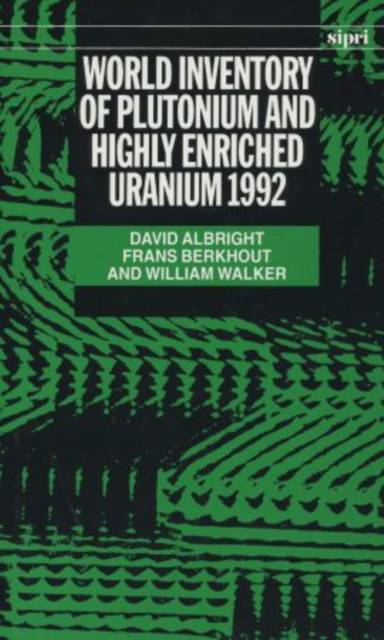
- Afhalen na 1 uur in een winkel met voorraad
- Gratis thuislevering in België vanaf € 30
- Ruim aanbod met 7 miljoen producten
- Afhalen na 1 uur in een winkel met voorraad
- Gratis thuislevering in België vanaf € 30
- Ruim aanbod met 7 miljoen producten
Zoeken
World Inventory of Plutonium and Highly Enriched Uranium, 1992
David Albright, Frans Berkhout, William Walker
€ 227,45
+ 454 punten
Omschrijving
Plutonium and highly enriched uranium (HEU) were first introduced fifty years ago. In the Manhattan project the amounts separated were measured in kilograms, enough for the first atomic bombs. Today there are about 1000 tons of plutonium and 1300 tons of HEU in existence, the result of the great expansion of nuclear weapon and nuclear power programmes in recent decades. Controlling and disposing of these vast quantities is now one of the most serious challenges facing the international community. Despite the great significance of plutonium and HEU for international security and nuclear commerce, there are no international statistics on these materials. Information on them is generally classified in countries possessing or trying to acquire nuclear weapons, and holders of civil materials only give information to safeguards agencies on condition that it remains confidential. This book fills the gap. It provides for the first time a comprehensive and authoritative assessment of the amounts of plutonium and HEU in military and civilian programmes, country by country. World Inventory of Plutonium and Highly Enriched Uranium 1992 is based on knowledge of how nuclear reactors, reprocessing and enrichment plants have been operated around the world. Step by step, it explains how civil and military nuclear programmes have been run, which technologies and facilities have been used, and what has happened to the materials produced by them. It details the huge amounts of plutonium and HEU that will be extracted from dismantled weapons as the United States and the former Soviet Union reduce their nuclear arsenals, and the equally large amounts of plutonium that will be separated from civil fuels in Britain, France, Japan and Russia if reprocessing plans are implemented. It also contains the most thorough examination yet of the efforts by Iraq, Israel, Pakistan, India and a few other countries to acquire the materials needed to build nuclear weapons. And throughout, the book points out the main uncertainties over the quantities and whereabouts of these vital materials. The book ends by stressing the need to end the over-supply of civil plutonium and to develop plans for disposing of surplus stocks of both plutonium and HEU. Much of the plutonium will have to be treated as a waste, while the HEU can be diluted and used as nuclear fuel. It also calls on the international community to end the secrecy surrounding these materials. The United Nations should publish annual statistics on every country's holdings of plutonium and HEU, including materials in nuclear weapon states.
Specificaties
Betrokkenen
- Auteur(s):
- Uitgeverij:
Inhoud
- Aantal bladzijden:
- 272
- Taal:
- Engels
- Reeks:
Eigenschappen
- Productcode (EAN):
- 9780198291534
- Verschijningsdatum:
- 8/04/1993
- Uitvoering:
- Hardcover
- Formaat:
- Genaaid
- Afmetingen:
- 160 mm x 240 mm
- Gewicht:
- 580 g

Alleen bij Standaard Boekhandel
+ 454 punten op je klantenkaart van Standaard Boekhandel
Beoordelingen
We publiceren alleen reviews die voldoen aan de voorwaarden voor reviews. Bekijk onze voorwaarden voor reviews.











